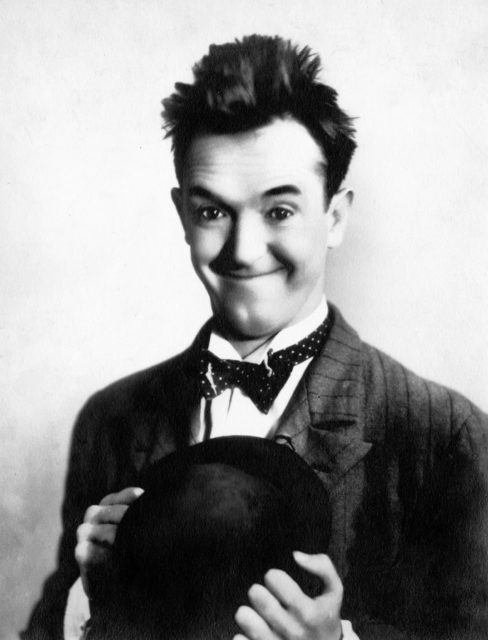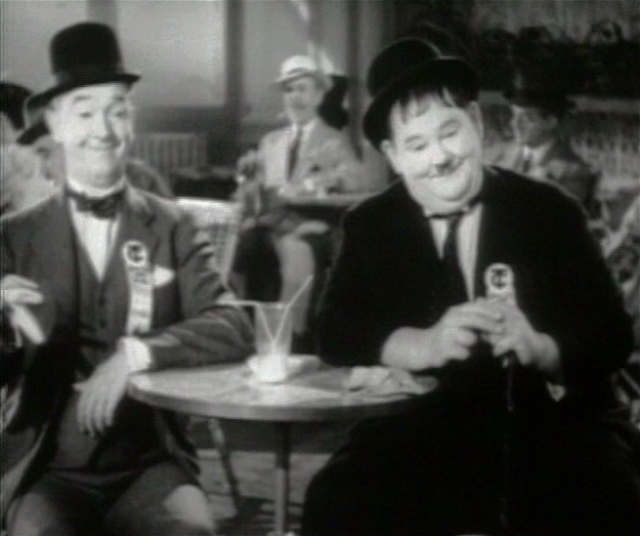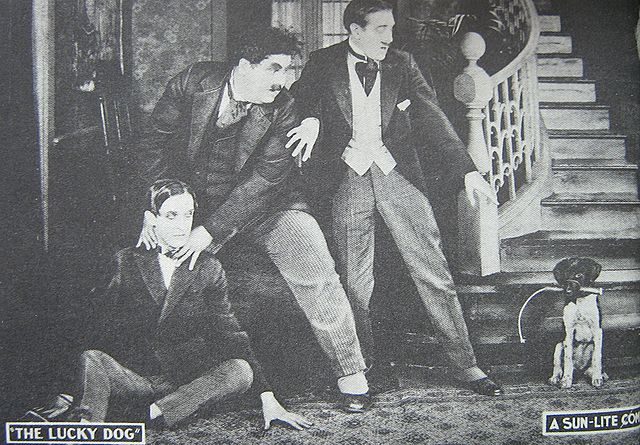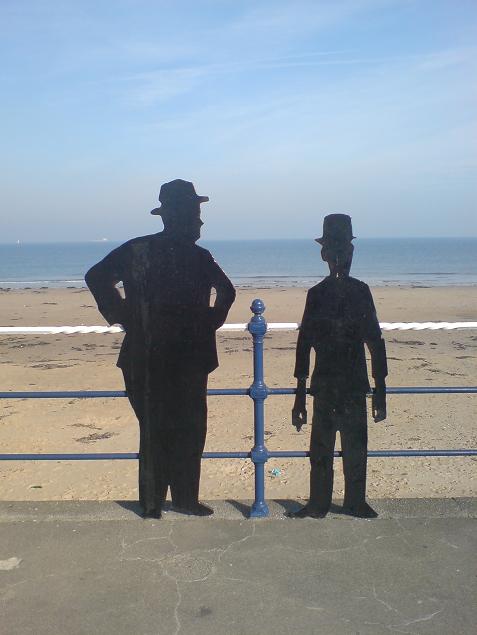Creatividad Internacional
Red de Literatura y Cine
Stan Laurel estaba demasiado enfermo para asistir al funeral de su inseparable amigo, Oliver Hardy
In the movie industry, it is not uncommon for friendships to transcend the relationship onscreen, but, it seems, there is none as genuine as that which stretched throughout the 23 full-length feature films, 32 silent shorts, 40 short sound films, and 12 guest and cameo appearances of the inseparable slapstick comedy duo Laurel and Hardy, the true representatives of the Golden Age of Comedy.
Right from their first appearance together in Duck Soup and Slipping Wives in 1927, Stan Laurel and Oliver “Babe” Hardy displayed great comic chemistry and from that point on performed exclusively as a duo. This collaboration would continue for 20 plus years, making the pair one of the most celebrated comedic duos of all time.
As much as they were inseparable friends and “partners in crime” in all of their mischiefs on the big screen, they were just as close in real life. In 1957, when Oliver Hardy passed away, Laurel, devastated by his best friend’s death, never fully recovered and so, retired from acting, refusing to perform on stage or act in another film without his best pal.
 Oliver Hardy (left) and Stan Laurel (right) in 1930’s “The New Movie”.
Oliver Hardy (left) and Stan Laurel (right) in 1930’s “The New Movie”.
It would seem as if the comedians were destined to reach greatness together, for it was fate that brought the two together with such spectacular results. In fact, their beginnings were very far apart. In 1890, Stan was born Arthur Stanley Jefferson, and in the early 1900’s, he worked in a music hall in England where he developed his theatrical and pantomime skills. Later on, he served as Charlie Chaplin’s understudy in the Fred Karno comedy troupe of actors, or the “Fred Karno’s Army,” and it was with these that, in 1912, he decided to move to the United States and pursue his career in acting.
 Arthur Stanley Jefferson (1890 – 1965) – English comic actor, entertainer, writer, and film director.
Arthur Stanley Jefferson (1890 – 1965) – English comic actor, entertainer, writer, and film director.
Around the same time, Norvell Hardy was born in Harlem, Georgia, in 1892, to Confederate veteran Oliver Hardy. Norvell also had a thing for music and theater and was a do-it-all and a stand-alone manager at the Milledgeville movie theater back home. He was the ticket salesman, the projectionist, the janitor, and the actual manager of the place. It was 1910 and Hardy was only 18 at the time. In 1913, knowing deep down he could do more than the actors he had been projecting on screen, he quit his job and moved to Florida to follow his acting dreams.
There, in Jacksonville, a go-to place for actors in those days, he worked at night for a period of time as a cabaret singer, and during the day, he found work at the American motion picture production company, Lubin Manufacturing Company. From 1896 to 1916, the Lubin films were the benchmark for silent films production in Florida, and with these, Hardy got his break, starring in his first ever movie Outwitting Dad (1914), billed as Oliver N. Hardy in the credits as a tribute to his dad.
The name stuck throughout his forthcoming movies, although in some of his shorts he was credited as “Babe Hardy,” a nickname earned in his childhood. Being huge, cute and chubby, weighing 300 pounds at 6’1”, and carrying a grumpy or smiley baby face, the name was too convenient for his roles to miss it out. Restricted by his size when it came to casting, he was almost always the big villain or the clumsy fella in the 50 shorts he filmed for the Lubin Company in less than two years, corresponding to his persona perfectly.
 Stan Laurel and Oliver Hardy in the opening scenes of their 1939 “The Flying Deuces”.
Stan Laurel and Oliver Hardy in the opening scenes of their 1939 “The Flying Deuces”.
In the period between 1914 and 1916, Hardy made 177 shorts as Babe with the Vim Comedy Company. A year later, in 1917, after the collapse of the movie industry in Florida, he moved to Los Angeles, where he worked for several years as a freelancer for some notable Hollywood studios, sometimes even working as a Charlie Chaplin imitator.
Simultaneously, Stan paired up with his later lifelong friends, Alice Cooke and Baldwin Cooke, who were already working in Hollywood, somewhat successfully even, starring as a lead in double act movies alongside his wife Mae Dahlberg.
 Lucky Dog (1921) – featuring the first appearance on film by Laurel and Hardy. Stan Laurel is seated with Oliver Hardy’s hands around his neck.
Lucky Dog (1921) – featuring the first appearance on film by Laurel and Hardy. Stan Laurel is seated with Oliver Hardy’s hands around his neck.
When Hardy arrived in L.A. in 1917, he almost instantly crossed paths with the young British comedian and was hired alongside him to work on a silent comedy called The Lucky Dog, released in 1921. In it, Stan, the young Brit, befriends a stray dog who ends up saving him on many occasions. Meanwhile, Hardy plays a mugger who tries to rob him and his beloved companion.
At the time of the shooting, they were neither friends nor acquaintances. Afterward, they would not share the screen again for some time.
Soon after, Stan signed with the Hal Roach Studio with the intention to write and direct movies, believing his talent was behind the camera instead of in front of it. Among the few directed by him was 1926’s Yes, Yes, Nanette, in which he also directed Hardy. At the time, Hardy was hired by the studio and already starred in some of their titles such as 1925’s Wizard of OZ, as the Thin Man.

That same year, Hardy was supposed to appear in Get ‘Em Young, however, strangely enough, he suffered a bizarre accident that left him injured while cooking a leg of lamb. Stan was then considered as a quick-to-go solution and was selected to fill in for the role, once again trying his hand in front of the camera. He did a great job according to Roach Studios’ supervising director Leo McCarey and so he offered him another role in 45 Minutes from Hollywood later that year, starring alongside Hardy. Yet again, however, they did not share a single scene together.
Finally, in the following year, McCarey, having witnessed them having similar taste in humor, tried them out in Slipping Wives and Duck Soup. The audience adored them, almost instantly. The chemistry was more than obvious, even to Hal Roach, who, convinced of their potential, decided to put them in a new movie Putting Pants on Philip, but this time as a double act. The short movie came out that same year and, being a huge success, it led to the start of a Laurel and Hardy series that would last for more than two decades.
 Lupe Vélez with Laurel & Hardy in Hollywood Party (1934).
Lupe Vélez with Laurel & Hardy in Hollywood Party (1934).
Often in the films, Oliver, the pompous “leader,” would think of a plan, if not for making money then certainly for winning some girl’s heart, while Stan on the other hand, the clumsy and childlike friend or the “shy klutz,” would always somehow find a way to mess it all up, in the end, leading them both into deep trouble. This is where Hardy would speak one of his most famous lines, “Well, here’s another nice mess you’ve gotten us into.”
They had their frustrations with each other of course, but even so, at the end of each movie they’d made, the best friends would always chuckle at their mischiefs and adventures together. They loved and accepted one another for who they truly were, humans with flaws and all.
 Stan Laurel and Oliver Hardy in their last movie Utopia (1951).
Stan Laurel and Oliver Hardy in their last movie Utopia (1951).
Their popularity skyrocketed, and Laurel and Hardy found themselves at the very top of Hollywood’s leading slapstick duos. Although the premise for the majority of their movies was almost always the same, the audience always left the theater in tears, laughing long after the end of the show.
If it wasn’t for that accident Oliver suffered while cooking, Stan might have never returned to acting, and the chemistry which resulted from the weird chance pairing of Stan and Babe might never have happened.
 Stan Laurel, Walt Disney and Oliver Hardy in the mid 30’s.
Stan Laurel, Walt Disney and Oliver Hardy in the mid 30’s.
That chemistry transcended into their real lives and became a long-lasting friendship, and interestingly enough, it was off-screen where their personalities were completely the opposite. Stan was the one who led more and had creative control over the direction their movies would take as well as the career decisions they would both make. Oliver, however, was quiet and reserved and with complete trust in his friend and his decisions.
Being the best of friends they preferred to stick together, such as when they broke their partnership with Hal Roach in the late 1930s, neither one went on their own to pursue life as a solo comedian. Instead, they searched for a studio that would have them both along with their interests and creative ideas. Eventually, that proved to be 20th Century Fox and MGM. When they decided to quit the movie business in 1950, Stan and Oliver continued to work together, touring Europe and having fun.
 Silhouette portrait of the duo in Redcar, England
Silhouette portrait of the duo in Redcar, England
Shortly after that, both of them fell ill, and on August 7, 1957, Oliver died of a major stroke. This left Stan devastated and he was at the time too ill to attend his funeral. After the ceremony, he wrote a public letter in which he stated, “I feel lost without him after 30 odd years of close friendship & happy association.” With his partner and best friend now gone, Stan refused to perform ever again.
What he did for the remainder of his eight years was to meet with their many fans, who were more than eager to hear some of the stories about them, and he was a always glad to share them, enabling him to reminisce over his dear friend while doing so.
.
Comentar
-
Comentario por Trina Mercedes Lee de Hidalgo el noviembre 4, 2017 a las 11:43pm
-
Interesante aporte, gracias por compartirlo. Abrazos en la distancia.
Libros – Editores
Creatividad Internacional es una red abierta, sin fines de lucro, donde no se tiene que registrar para ver su información y colaboraciones, hay +6,000 Foros de Discusiones sobre grandes escritores y cineastas; actualización diaria de noticias literarias y cinematográficas y +18,000 blogs con creaciones literarias de gran talento.
Un espacio consolidado desde hace 15 años para exponer creaciones y opiniones a críticos, editores y productores. Los invitamos cordialmente a participar y ser parte de nuestra comunidad.
Ismael Lorenzo
Director
Robert Allen Goodrich, Subdirector
Liss Rivas Clisson, Subdirectora
Alina Galliano R.I.P.
Jorge Dominguez, Carlos Rubio, Oscar Martínez Molina, Eduardo Casanova
Consejo Editorial
_____________
PROGRAMACIÓN RADIAL DE 'CREATIVIDAD INTERNACIONAL'
ENTREVISTAS, CINE Y LIBROS, CONVERSATORIOS
784 Programas radiales, +89,975
visualizaciones en Youtube, Pags en FB, Twitter y en Instagram.
___________
"Creatividad Internacional' no se hace responsable por los contenidos y opiniones publicados por sus miembros.
Somos una entidad sin fines de lucro.
_____________
PREMIO LITERARIO "REINALDO ARENAS" DE CREATIVIDAD INTERNACIONAL 2024'
Género: NOVELA Este año 2024 en su 10ma entrega será para 'Novela'.
_____________
La niña del zapato roto, de Griselda Roja
___________
Ismael Lorenzo
'El silencio de los 12', narra las historias, en sus propias voces, de mujeres agredidas sexualmente, sus consecuencias y secuelas de estos abusos. Desde el Líbano hasta España, desde Francia hasta Italia
Nueva edición revisada
__________
'Matías Pérez baila la Macarena
Ismael Lorenzo
La Pentalogía de los 'Matías Pérez', iniciada hace un par de décadas: 'Matías Pérez entre los locos', 'Matías Pérez regresa a casa', 'Matías Pérez en los días de invierno', 'Matías Pérez de viaje por el Caribe', y 'Matías Pérez baila la Macarena'. Disponibles en las Amazon.
MATIAS PEREZ BAILA LA MACARENA
____________
Amigos en Tiempos Difíciles'
Ismael Lorenzo
En este libro recién publicado 'Amigos en Tiempos Difíciles', Ismael Lorenzo describe las vicisitudes y pérdidas sufridas por la estafa que condujo a una orden judicial de desalojo y como muchos volvieron la espalda pero aparecieron otros
__________
PREMIO LITERARIO 'REINALDO ARENAS, DE CREATIVIDAD INTERNACIONAL 2024'
En el 2023, su 9va versión, el ganador ha sido Carlos Fidel Borjas.
En el 2024 ha sido Miguel Angel Teposteco.
_________
Libros de Ismael Lorenzo
_________
‘Años de sobrevivencia’, es la continuación de las memorias comenzadas en ‘Una historia que no tiene fin', y donde se agregan relatos relacionados a su vida de escritor y a su obra
__________
Madame Carranza
Renée Pietracconi
La novela basada en hechos reales relatados por Josefina, tía abuela de Renée y añadiendo un poco de ficción para atraparnos en historias dentro de historia
_________
Casa Azul Ediciones
Súmate a la campana de promoción a la lectura
TE INVITO A LEER
Email: casazulediciones@gmail.com
'Creatividad Internacional', red de Literatura y Cine, un espacio para exponer creaciones y opiniones a críticos, editores y productores.
© 2024 Creado por Creatividad Internacional.
Tecnología de
![]()
¡Necesitas ser un miembro de Creatividad Internacional para añadir comentarios!
Participar en Creatividad Internacional